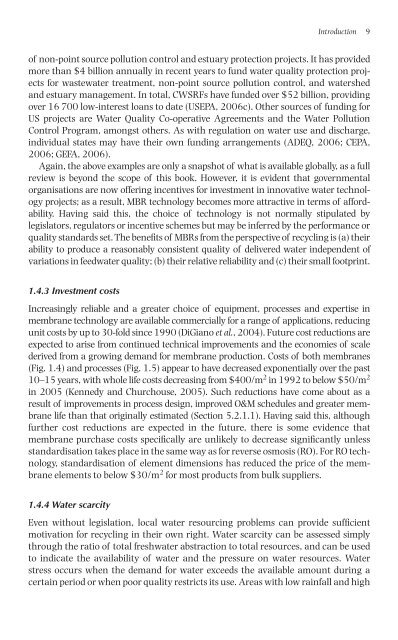The MBR Book: Principles and Applications of Membrane
The MBR Book: Principles and Applications of Membrane
The MBR Book: Principles and Applications of Membrane
Create successful ePaper yourself
Turn your PDF publications into a flip-book with our unique Google optimized e-Paper software.
<strong>of</strong> non-point source pollution control <strong>and</strong> estuary protection projects. It has provided<br />
more than $4 billion annually in recent years to fund water quality protection projects<br />
for wastewater treatment, non-point source pollution control, <strong>and</strong> watershed<br />
<strong>and</strong> estuary management. In total, CWSRFs have funded over $52 billion, providing<br />
over 16 700 low-interest loans to date (USEPA, 2006c). Other sources <strong>of</strong> funding for<br />
US projects are Water Quality Co-operative Agreements <strong>and</strong> the Water Pollution<br />
Control Program, amongst others. As with regulation on water use <strong>and</strong> discharge,<br />
individual states may have their own funding arrangements (ADEQ, 2006; CEPA,<br />
2006; GEFA, 2006).<br />
Again, the above examples are only a snapshot <strong>of</strong> what is available globally, as a full<br />
review is beyond the scope <strong>of</strong> this book. However, it is evident that governmental<br />
organisations are now <strong>of</strong>fering incentives for investment in innovative water technology<br />
projects; as a result, <strong>MBR</strong> technology becomes more attractive in terms <strong>of</strong> affordability.<br />
Having said this, the choice <strong>of</strong> technology is not normally stipulated by<br />
legislators, regulators or incentive schemes but may be inferred by the performance or<br />
quality st<strong>and</strong>ards set. <strong>The</strong> benefits <strong>of</strong> <strong>MBR</strong>s from the perspective <strong>of</strong> recycling is (a) their<br />
ability to produce a reasonably consistent quality <strong>of</strong> delivered water independent <strong>of</strong><br />
variations in feedwater quality; (b) their relative reliability <strong>and</strong> (c) their small footprint.<br />
1.4.3 Investment costs<br />
Increasingly reliable <strong>and</strong> a greater choice <strong>of</strong> equipment, processes <strong>and</strong> expertise in<br />
membrane technology are available commercially for a range <strong>of</strong> applications, reducing<br />
unit costs by up to 30-fold since 1990 (DiGiano et al., 2004). Future cost reductions are<br />
expected to arise from continued technical improvements <strong>and</strong> the economies <strong>of</strong> scale<br />
derived from a growing dem<strong>and</strong> for membrane production. Costs <strong>of</strong> both membranes<br />
(Fig. 1.4) <strong>and</strong> processes (Fig. 1.5) appear to have decreased exponentially over the past<br />
10–15 years, with whole life costs decreasing from $400/m 2 in 1992 to below $50/m 2<br />
in 2005 (Kennedy <strong>and</strong> Churchouse, 2005). Such reductions have come about as a<br />
result <strong>of</strong> improvements in process design, improved O&M schedules <strong>and</strong> greater membrane<br />
life than that originally estimated (Section 5.2.1.1). Having said this, although<br />
further cost reductions are expected in the future, there is some evidence that<br />
membrane purchase costs specifically are unlikely to decrease significantly unless<br />
st<strong>and</strong>ardisation takes place in the same way as for reverse osmosis (RO). For RO technology,<br />
st<strong>and</strong>ardisation <strong>of</strong> element dimensions has reduced the price <strong>of</strong> the membrane<br />
elements to below $30/m 2 for most products from bulk suppliers.<br />
1.4.4 Water scarcity<br />
Introduction 9<br />
Even without legislation, local water resourcing problems can provide sufficient<br />
motivation for recycling in their own right. Water scarcity can be assessed simply<br />
through the ratio <strong>of</strong> total freshwater abstraction to total resources, <strong>and</strong> can be used<br />
to indicate the availability <strong>of</strong> water <strong>and</strong> the pressure on water resources. Water<br />
stress occurs when the dem<strong>and</strong> for water exceeds the available amount during a<br />
certain period or when poor quality restricts its use. Areas with low rainfall <strong>and</strong> high



